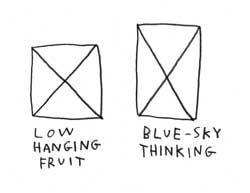Interviewsand Articles
Portfolio: Tucker Nichols
by Richard Whittaker, May 2, 2005

As I was leaving, Nichols handed me two little books, Lost Data and Look A Whale.
 I'd come to meet him and to see his installation, Together We Can Prevent Earthquakes, a work in progress. Four or five days a week he worked on it for a few hours a day at Mission 17 Gallery in San Francisco. He'd sit in a chair contemplating a blank wall or walk around the empty room and look out the window down at the bustle of Mission St. There was music in the background. As inspiration provided, Nichols would approach the wall and write or draw something on it, "Running or not in most cases," for instance.
I'd come to meet him and to see his installation, Together We Can Prevent Earthquakes, a work in progress. Four or five days a week he worked on it for a few hours a day at Mission 17 Gallery in San Francisco. He'd sit in a chair contemplating a blank wall or walk around the empty room and look out the window down at the bustle of Mission St. There was music in the background. As inspiration provided, Nichols would approach the wall and write or draw something on it, "Running or not in most cases," for instance.
By the time I showed up, a network of words, diagrams and phrases had collected on the wall, the results of previous days of contemplation -- examples of the random bits and pieces rescued from the tide of flotsam always passing through one's mental space. Each phrase and cogno-bit, emoticon and inner ricochet that crossed the divide and appeared on the wall would have to rise to a certain level of ... something. What might the criteria be? Attempts to analyze such playful sparks of wit, visual or linguistic -- or both in this case -- are as difficult to pull off as an "artist's statement."
Not too long after my visit, I got a message from Nichols. The New York Times had published something of his in their Op/Ed section a day or two before, the piece to the right, “Depends…”
A few weeks were yet to pass before this issue was ready to go to press. One morning while getting some coffee, atypically, I picked up a copy of the NY Times. Making my way leisurely through the paper, by chance, I spotted a suspicious looking drawing in the “Letters” section. Peering in more closely there was the name, “Tucker Nichols.” What were the chances, I wondered? Maybe there is something to this method of working. —RW
About the Author
Richard Whittaker is the founding editor of works & conversations and West Coast editor of Parabola magazine.
SUBSCRIBE NOW
TO OUR MONTHLY NEWSLETTER









Share Your Comments and Reflections on this Conversation: